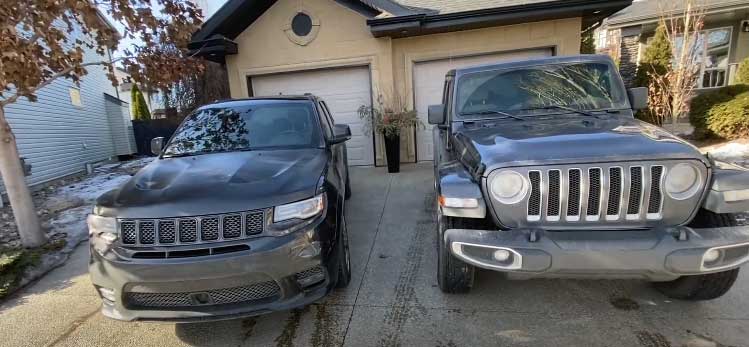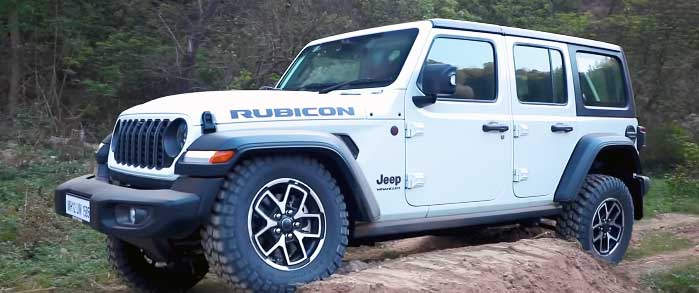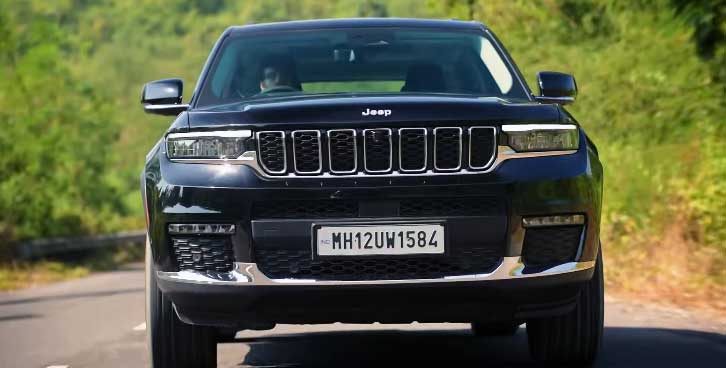I’ve always been captivated by Jeeps—their rugged charm, off-road prowess, and that undeniable sense of adventure. When I decided to buy one, I faced a tough choice: the iconic Jeep Wrangler or the versatile Jeep Grand Cherokee? Both are legends, but they cater to different lifestyles.
In this article, I’ll share my experience comparing these two, breaking down their pros, cons, and key features to help you decide which Jeep fits your life best.

Comparison Table of Jeep Wrangler and Jeep Grand Cherokee Features
| Feature | Jeep Wrangler (2025) | Jeep Grand Cherokee (2025) |
| Starting MSRP | $34,090 | $38,490 |
| Engine Options | 2.0L Turbo 4-cylinder, 3.6L V6, 4xe PHEV | 2.0L Turbo 4-cylinder, 3.6L V6, 4xe PHEV |
| Horsepower | 270-375 hp | 270-375 hp |
| Fuel Economy (City/Hwy) | 17/23 MPG (V6) | 19/26 MPG (V6) |
| Towing Capacity | Up to 3,500 lbs (4-door) | Up to 6,200 lbs (V6), 6,000 lbs (4xe) |
| Cargo Space | 12.9 ft³ (seats up), 70.8 ft³ (seats folded) | 37.7 ft³ (seats up), 70.8 ft³ (seats folded) |
| Ground Clearance | 10.1-10.8 inches (4xe) | 8.4-10.9 inches (4xe) |
| Off-Road Capability | Rock-Trac 4WD, skid plates, high clearance | Quadra-Trac II, Quadra-Lift suspension |
| Interior | Rugged, functional, removable tops/doors | Luxurious, spacious, premium materials |
| Seating | 4-5 passengers | 5 passengers (2-row), 6-7 (L model) |
| Infotainment | Uconnect 5, 12.3-inch touchscreen | Uconnect 5, 10.1-inch touchscreen |
| Safety Features | Adaptive cruise, blind-spot monitoring | Lane-keeping, 360-degree camera, blind-spot |
My Experience Driving the Jeep Wrangler
The Jeep Wrangler has been calling my name since I was a kid, dreaming of open-air adventures and tackling trails most vehicles wouldn’t dare touch. Its boxy design, with those signature round headlights and seven-slot grille, feels like a nod to Jeep’s heritage. When I slid behind the wheel of a 2025 Wrangler, it was like stepping into a legacy of freedom.

Advantages of Choosing the Jeep Wrangler
The Wrangler’s off-road capability is unmatched. Its ladder-frame chassis, up to 10.8 inches of ground clearance in the 4xe, and available Rock-Trac 4WD system make it a beast on rocks, mud, and steep inclines. I took a Rubicon model on a rocky trail in Colorado, and it crawled over boulders like they were nothing. Skid plates and heavy-duty axles gave me confidence to push it to the limit.
The open-air experience is pure magic. With removable tops and doors, I drove along a coastal road with the wind in my hair, feeling like I was part of the landscape. The Wrangler’s compact size—96.8-inch wheelbase for the two-door, 118.4 for the four-door—makes it nimble on tight trails, slipping through gaps where others would get stuck.
The 2025 Wrangler surprised me with modern tech. The Uconnect 5 system, with its 12.3-inch touchscreen, is crisp and supports wireless Apple CarPlay and Android Auto.1 Safety features like adaptive cruise control and blind-spot monitoring made highway driving less stressful. The 4xe plug-in hybrid offers 21 miles of electric range, perfect for short commutes without gas. Plus, the Wrangler’s resale value is stellar, retaining about 69.5% of its value after five years, outpacing most SUVs.
Drawbacks of the Jeep Wrangler
But the Wrangler has its quirks. On-road, it’s a handful. Highway driving felt like wrestling a tractor—wind noise from the soft top was loud, and the steering was vague. The off-road-focused suspension made long drives bumpy and tiring. Cargo space is limited, with just 12.9 cubic feet behind the rear seats. Even with 70.8 cubic feet when folded, it filled up fast with camping gear. The back seat, especially in the two-door, is cramped, and getting in feels like a workout.
Fuel economy isn’t great unless you opt for the 4xe. The V6 averages 17/23 MPG, costing about $2,100 a year for 15,000 miles at $3.50 per gallon. The starting price of $34,090 is reasonable, but a loaded Rubicon 392 can hit $70,000, which feels steep for the comfort level. Reliability is solid at 8.5/10, but I heard from other owners about electrical issues or leaks with the removable top, which made me cautious.
My Experience Driving the Jeep Grand Cherokee
The Grand Cherokee felt like the Wrangler’s sophisticated sibling. When I settled into the driver’s seat of a 2025 model, the plush interior, with its quilted leather and wood trim, made me feel like I was in a luxury SUV. It’s a Jeep that promises adventure without sacrificing the comforts I crave daily.

Advantages of Choosing the Jeep Grand Cherokee
The Grand Cherokee’s interior is a standout. The Summit trim’s 10.1-inch Uconnect 5 touchscreen felt like a tablet, and the cabin’s premium materials rivaled high-end competitors. Cargo space is generous—37.7 cubic feet behind the second row, 70.8 with seats folded, and up to 84.6 in the three-row L model. I easily fit a cooler, chairs, and a cornhole set for a family barbecue.
On-road, it’s a dream. The available Quadra-Lift air suspension smoothed out bumps, and the steering was precise. A 300-mile road trip felt effortless, unlike the Wrangler’s fatiguing ride. The 3.6L V6 delivers 293 horsepower, but the 4xe’s 375 horsepower and 470 lb-ft of torque felt punchy, with 26 miles of electric range and 23 MPG combined. Towing capacity up to 6,200 pounds (V6) is perfect for trailers or boats.
Safety is robust, with a 360-degree camera, lane-keeping assist, and a five-star NHTSA crash-test rating. Its reliability rating of 8.7/10 gave me peace of mind.
Drawbacks of the Jeep Grand Cherokee
The Grand Cherokee’s starting price of $38,490 is higher than the Wrangler’s, and a loaded Summit Reserve can hit $90,000, rivaling luxury SUVs without the badge prestige. Build quality is solid but doesn’t always match competitors like the BMW X5 at that price. Off-road, the Trailhawk 4xe is capable with Quadra-Drive II and skid plates, but its longer wheelbase (116.7 inches for two-row, 121.7 for L) feels less agile on extreme trails. Fuel economy at 19/26 MPG (V6) lags behind rivals like the Honda Passport’s 30 MPG highway. The high lift-over height made loading heavy items a bit tricky.
Off-Road Performance Capabilities
I’m an off-road enthusiast, so I pushed both Jeeps on trails. The Wrangler was in its element. Its short wheelbase and high approach/departure angles (44/37 degrees) tackled steep inclines and tight turns effortlessly. The Rubicon’s locking differentials and Rock-Trac system made rocky paths feel like a playground. I felt like I could go anywhere.
The Grand Cherokee’s Trailhawk 4xe held its own on moderate trails. The Quadra-Lift suspension raised it to clear obstacles, and Quadra-Drive II provided solid traction. But on a rocky section, its longer wheelbase felt cumbersome, and I worried about scraping the undercarriage. It’s great for light off-roading or snowy roads, but it’s not the Wrangler’s equal on tough terrain.
On-Road Comfort and Handling
Daily driving highlighted their differences. The Wrangler’s bumpy ride and noisy cabin wore me out on commutes. The soft top amplified wind noise, and even the hardtop wasn’t much better. It’s fun for short trips, but long highway drives felt exhausting.
The Grand Cherokee was a sanctuary. Its quiet cabin, supportive seats, and smooth suspension made a 300-mile trip feel effortless. The optional 19-speaker McIntosh audio system was a treat, though the touchscreen caught glare at times. It’s the clear winner for daily comfort.
Long-Term Ownership Costs and Considerations
Owning a Jeep is about more than the purchase price—it’s about the long haul. The Wrangler’s $34,090 base price is attractive, but options like the Rubicon 4xe push it to $70,000. At 17/23 MPG (V6), 15,000 miles a year at $3.50 per gallon costs about $2,100 annually. The 4xe saves with its electric range. Maintenance runs $800-$1,000 yearly, per owner forums, with occasional electrical fixes. Insurance averages $1,200 annually for full coverage. The Wrangler’s 69.5% resale value after five years is a strong point.
The Grand Cherokee starts at $38,490, with high-end trims hitting $90,000. Its 19/26 MPG costs about $1,800 yearly for the same mileage. The 4xe is pricier upfront but saves on fuel. Maintenance is similar, $800-$1,200, with fewer reported issues. Insurance is slightly higher at $1,300 due to its value. Resale value is solid but lower at 65% after five years.
Comparing to Competitors in the SUV Market
To put these Jeeps in context, I compared them to rivals. The Wrangler’s closest competitor is the Ford Bronco, starting at $36,050. It matches the Wrangler’s off-road prowess with G.O.A.T. modes and 11.6 inches of ground clearance in the Badlands trim. But its interior feels less rugged, and the ride is slightly smoother on-road. The Bronco’s resale value is close at 68%, but its reliability rating of 8.3/10 trails the Wrangler. I found the Bronco’s tech less intuitive than Uconnect.
The Grand Cherokee faces the Toyota 4Runner, starting at $40,950. The 4Runner offers 9.6 inches of ground clearance and a 5,000-pound towing capacity, but its dated 4.0L V6 and 16/19 MPG feel inefficient. Its interior is functional but lacks the Grand Cherokee’s luxury. The 4Runner’s reliability is top-notch at 9/10, and its resale value shines at 70%. I preferred the Grand Cherokee’s refinement, but the 4Runner’s simplicity appealed to my minimalist side.
Lifestyle Scenarios for Jeep Buyers
Your lifestyle shapes your choice. The Wrangler is for adventurers who crave off-road thrills and that open-air vibe. I took it camping in the Rockies, and its compact size and removable top made it perfect for solo escapes. It’s ideal for young couples or singles who prioritize fun over practicality. But with kids or a long commute, its cramped space and rough ride might frustrate you.
The Grand Cherokee suits families or professionals. I loaded it for a family road trip, and the spacious cargo area and rear-seat entertainment kept everyone happy. It’s great for towing boats or commuting in style. If you want a Jeep that blends adventure with everyday comfort, this is your pick.
Technology and Safety Features
The Wrangler’s tech has improved significantly. The 12.3-inch Uconnect 5 system is responsive, with navigation that guided me through remote trails. Safety features like adaptive cruise control and forward collision warning were reassuring, though the backup camera’s resolution felt dated. The Grand Cherokee’s tech is a step up, with a sharper 10.1-inch display and optional features like night vision and a 360-degree camera. Its intersection collision avoidance saved me from a close call at a busy crossing.
Driving Dynamics and Performance
The Wrangler’s 2.0L turbo (270 hp) felt peppy in town, but the V6 (285 hp) had more grunt for trails. The 4xe’s 375 hp was a blast, though its weight dulled handling. The Grand Cherokee’s V6 was smooth for cruising, and the 4xe’s torque made passing effortless. Both handle well for their size, but the Grand Cherokee’s air suspension and tighter steering make it the better road companion.
Frequently Asked Questions (FAQ)
The Grand Cherokee has a slightly better reliability rating (8.7/10) than the Wrangler (8.5/10), based on owner reports and industry data.
Its rough ride, limited cargo space, and poor fuel economy (17/23 MPG) make it less practical for daily driving or families.
Both can last over 200,000 miles with proper maintenance, but the Grand Cherokee’s smoother ride may reduce wear on components.
The Wrangler offers better resale value (69.5% after five years) and a lower starting price, making it a better long-term investment.
Final Thoughts on Choosing Your Jeep
Choosing between the Wrangler and Grand Cherokee was a journey of balancing heart and head. The Wrangler stole my soul with its raw, adventurous spirit—perfect for weekend warriors who live for the trail and that open-air freedom. But the Grand Cherokee won me over for daily life, offering comfort, space, and versatility without sacrificing too much off-road cred.
Your choice hinges on what you value most: the Wrangler’s unmatched thrill or the Grand Cherokee’s do-it-all nature. Take both for a test drive, think about your lifestyle, and you’ll find the Jeep that feels like home.

